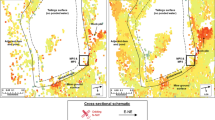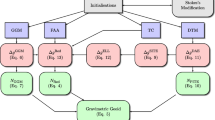Abstract
Analytical simulation of the gravity response due to a square prism buried at known depths has been done and the resulting data have been upward continued to various heights. This was done with the aim of studying the constraints impeding the correct application of the upward continuation filter and the conditions necessary for consistency in the determination of height of upward continuation of gravity field by means of spectral analysis. 3D gravity response of a square prism with known thickness, dimensions and depth of burial was simulated using the expression for the gravity attraction due to a prism. Spectral analysis was then performed on the gravity response data to determine the depth to the top of the prism which was subsequently compared with the value of depth used in the simulation for agreement. Following this, upward continuation operation was performed on the simulated data to a known height such that the total depth to the buried body becomes the sum of depth of burial and the height of upward continuation. Spectral analysis was again performed on the upward continued data in order to compare if the expected total depth to the top of the buried body, which is the sum of the depth to the top of the prism from the ground level and the height of upward continuation, agrees with the depth estimate obtained from spectral analysis. The height of upward continuation at which the depth determined from spectral analysis start to differ significantly was noted. The depth to the top of the square prism was increased in a stepwise manner and the process was repeated. The height of upward continuation at which the depth determined from spectral analysis start to differ significantly was noted for all the various depths of burial as well. Results obtained showed that the computed depth from spectral analysis starts to differ significantly from expected depths at the total depth that is about half of the data grid size. Result also showed that the relationship between the height to which gravity data is upward continued and the true output effect verifiable by spectral analysis method of depth evaluation is ratio 1:1. The study concluded that the upward continuation filter is highly reliable when the aliasing threshold, which is half the data grid size, has not been exceeded.














Similar content being viewed by others
Internet Resource
https://tuprints.ulb.tu-darmstadt.de/362/8/chapter4.pdf (accessed on 14/07/2022)
References
Baniamerian, J., Liu, S., & Abbas, M. A. (2018). Stable computation of the vertical gradient of potential field data based on incorporating the smoothing filters. Pure and Applied Geophysics, 175, 2785–2806.
Barnes, G., & Lumley, J. (2011). Processing gravity gradient data. Geophysics, 76(2), I33–I47.
Blakely, R. J. (1988). Curie temperature isotherm analysis and tectonic implications of aeromagnetic data from Nevada. Journal of Geophysical Research: Solid Earth, 93(B10), 11817–11832.
Blakely, R. J. (1996). Potential theory in gravity and magnetic applications. Cambridge University Press.
Boashash, B. (2015). Time-frequency signal analysis and processing: a comprehensive reference. Academic press.
Connard, G., Couch, R., & Gemperle, M. (1983). Analysis of aeromagnetic measurements from the Cascade Range in central Oregon. Geophysics, 48(3), 376–390.
Foulger, G. R., & Pierce, C. (2007). Geophysical methods in geology. University of Durham, UK.
Friedenthal, S., Moore, A. and Steiner, R. A. (2014). Practical Guide to SysML: the systems modelling language. Morgan Kaufmann; 2014 Oct 23.
García-Abdeslem, J., & Ness, G. E. (1994). Crustal structure of the eastern part of the Maya Terrane from magnetic anomalies and magnetic power spectrum inversion. Geofísica Internacional, 33(3), 399–420.
Guo, L., Meng, X., Chen, Z., Li, S., & Zheng, Y. (2013). Preferential filtering for gravity anomaly separation. Computers & Geosciences, 51, 247–254.
Hahn, A., Kind, E. G., & Mishra, D. C. (1976). Depth estimation of magnetic sources by means of Fourier amplitude spectra. Geophysical Prospecting, 24(2), 287–306.
Hornby, P., Boschetti, F., & Horowitz, F. G. (1999). Analysis of potential field data in the wavelet domain. Geophysical Journal International, 137(1), 175–196.
Huang, N. E., & Wu, Z. (2008). A review on Hilbert-Huang transform: Method and its applications to geophysical studies. Reviews of Geophysics. https://doi.org/10.1029/2007RG000228
Jacobsen, B. H. (1987). A case for upward continuation as a standard separation filter for potential-field maps. Geophysics, 52(8), 1138–1148.
Jekeli, C., 1981. The downward continuation to the earth’s surface of truncated spherical and ellipsoidal harmonic series of the gravity and height anomalies. The Ohio State University.
LaFehr T. R. and Nabighian, M. N. (2012). Fundamentals of gravity exploration. Geophysical Monograph Series No 17, Society of Exploration Geophysicists, pp. 118–119.
Long, J. F. (1995). Complexity, accuracy, and utility of official population projections. Mathematical Population Studies, 5(3), 203–216.
Morrison, F., 2012. The art of modeling dynamic systems: Forecasting for chaos, randomness and determinism. Courier Corporation.
Nabighian, M. N., Ander, M. E., Grauch, V. J. S., Hansen, R. O., LaFehr, T. R., LI, Y., Pearson, W. C., Peirce, J. W., Phillips, J. D., & Ruder, M. E. (2005). Historical development of the gravity method in exploration. Geophysics, 70(6), 63–89. https://doi.org/10.1190/1.2133785
Naidu, P. S. (1972). Maximum likelihood (ML) estimation of depth from the spectrum of aeromagnetic fields. Pure and Applied Geophysics., 95, 141–149.
Nordstrom, D. K. (2012). Models, validation, and applied geochemistry: Issues in science, communication, and philosophy. Applied Geochemistry, 27(10), 1899–1919.
Okubo, Y., & Matsunaga, T. (1994). Curie point depth in northeast Japan and its correlation with regional thermal structure and seismicity. Journal of Geophysical Research: Solid Earth, 99(B11), 22363–22371.
Pawlowski, R. S. (1995). Preferential continuation for potential-field anomaly enhancement. Geophysics, 60, 390–398.
Pederson, M. R., & Jackson, K. A. (1991). Pseudoenergies for simulations on metallic systems. Physical Review B, 43(9), 7312.
Pilkington, M., & Todoeschuck, J. P. (1990). Stochastic inversion for scaling geology. Geophysical Journal International, 102(1), 205–217.
Quartly, G. D., Nencioli, F., Raynal, M., Bonnefond, P., Nilo Garcia, P., Garcia-Mondéjar, A., Flores de la Cruz, A., Crétaux, J. F., Taburet, N., Frery, M. L., & Cancet, M. (2020). The roles of the S3MPC: monitoring, validation and evolution of Sentinel-3 altimetry observations. Remote Sensing, 12(11), 1763.
Rawat, K. S., Singh, S. K., Singh, M. I., & Garg, B. L. (2019). Comparative evaluation of vertical accuracy of elevated points with ground control points from ASTERDEM and SRTMDEM with respect to CARTOSAT-1DEM. Remote Sensing Applications: Society and Environment, 13, 289–297.
Regan, R. D., & Hinze, W. J. (1976). The effect of finite data length in the spectral analysis of ideal gravity anomalies. Geophysics, 41(1), 44–55.
Reilley, K. A., Edwards, S., Peak, R., & Marvis, D. (2016). Methodologies for modelling and simulation in model-based systems engineering tools. AVAA SPACE, 2016, 5469.
Reynolds, J. M. (2011). An introduction to applied and environmental geophysics. John Wiley & Sons.
Roberts, A. (2001). Curvature attributes and their application to 3 D interpreted horizons. First Break, 19(2), 85–100.
Shin, Y. H., Choi, K. S., & Xu, H. (2006). Three-dimensional forward and inverse models for gravity fields based on the fast fourier transform. Computers & Geosciences, 32(6), 727–738.
Shuey, R. T., Schellinger, D. K., Tripp, A. C., & Alley, L. B. (1977). Curie depth determination from aeromagnetic spectra. Geophysical Journal International, 50(1), 75–101.
Spector, A., & Grant, F. S. (1970). Statistical models for interpreting aeromagnetic data. Geophysics, 35(2), 293–302.
Stallone, A., Cicone, A., & Materassi, M. (2020). New insights and best practices for the successful use of empirical mode decomposition, iterative filtering and derived algorithms. Scientific Reports, 10(1), 1–15.
Swanson, D. A. (2015). On the relationship among values of the same summary measure of error when used across multiple characteristics at the same point in time: an examination of MALPE and MAPE. Review of Economics and Finance, 5(1), 1–14.
Telford, W. M., Geldart, L. P., & Sheriff, R. E. (1990). Applied Geophysics (2nd ed., pp. 32–44). Cambridge University Press.
Willmott, C. J., & Matsuura, K. (2005). Advantages of the mean absolute error (MAE) over the root mean square error (RMSE) in assessing average model performance. Climate Research, 30(1), 79–82.
Xu, D., & Zeng, H. (2000). Preferential continuation and its application to Bouguer gravity anomaly in China in Chinese with English abstract. Geoscience, 14, 215–222.
Xu, S. Z., Yang, J., Yang, C., Xiao, P., Chen, S., & Guo, Z. (2007). The iteration method for downward continuation of a potential field from a horizontal plane. Geophysical Prospecting, 55(6), 883–889.
Yilmaz, O. Z. (2001). Seismic data analysis: Processing, inversion, and interpretation of seismic data. Society of exploration geophysicists.
Zeng, H., & Xu, D. (2001). Discussion on “Preferential continuation for potential-field anomaly enhancement” (R. Pawlowski, Geophysics, 60, 390–398). Geophysics, 66, 695–697.
Zeng, H., Xu, D., & Tan, H. (2007). A model study for estimating optimum upward-continuation height for gravity separation with application to a Bouguer gravity anomaly over a mineral deposit, Jilin province, northeast China. Geophysics, 72(4), 145–150.
Funding
The authors declare that no funds, grants, or other support were received during the preparation of this manuscript.
Author information
Authors and Affiliations
Contributions
BOB conceptualised, supervised, validated the results and wrote the write-up; OFA simulated the prisms numerically, did part of the modeling and spectral analysis; NAD did part of the modeling and spectral analysis.
Corresponding author
Ethics declarations
Conflict of Interest
The authors have no relevant financial or non-financial interests to disclose.
Additional information
Publisher's Note
Springer Nature remains neutral with regard to jurisdictional claims in published maps and institutional affiliations.
Appendix
Appendix
Tables of Values Generated for Gravity Response Simulated for a Buried Square Prism at Varying Depths of Burial (Tables 7, 8, 9)
Rights and permissions
Springer Nature or its licensor (e.g. a society or other partner) holds exclusive rights to this article under a publishing agreement with the author(s) or other rightsholder(s); author self-archiving of the accepted manuscript version of this article is solely governed by the terms of such publishing agreement and applicable law.
About this article
Cite this article
Balogun, O.B., Akereke, O.F. & Nwobodo, A.D. Understanding the Constraints to the Correct Application of the Upward Continuation Operation in Gravity Data Processing. Pure Appl. Geophys. 180, 3787–3811 (2023). https://doi.org/10.1007/s00024-023-03348-1
Received:
Revised:
Accepted:
Published:
Issue Date:
DOI: https://doi.org/10.1007/s00024-023-03348-1




